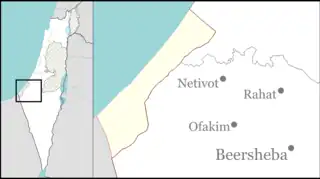Nir Oz
Nir Oz (Hebrew: נִיר עֹז, ניר עוז, lit. 'Meadow of Strength') is a kibbutz in southern Israel. It is located in the northwestern Negev desert between Magen and Nirim, and covers 20,000 dunams. Nir Oz is under the jurisdiction of Eshkol Regional Council. In 2021, it had a population of 393.[1]
Nir Oz
נִיר עֹז | |
|---|---|
 Nir Oz  Nir Oz | |
| Coordinates: 31°18′37″N 34°24′8″E | |
| Country | Israel |
| District | Southern |
| Council | Eshkol |
| Affiliation | Kibbutz Movement |
| Founded | 1 October 1955 |
| Founded by | Nahal |
| Population (2021)[1] | 393 |

History
Founded on 1 October 1955 as a Nahal settlement, Nir Oz was recognized as a kibbutz two months later. According to a resident named Shlomo Margalit in 2013, there had been a moshav on the site around 1952, "but too many members were killed by the fedayeen or left, so it was dissolved."[2] There were only four trees growing at the kibbutz at the time of its founding; it was developed over time into a model for low-water landscaping.[3] The Hashomer Hatzair took over Nir Oz in May 1957, with a founding group of 70 members.[2]
Due to its proximity to Gaza, Nir Oz farmers often come under Palestinian sniper fire. In 2008, the Israel Defense Forces asked the kibbutz to harvest its potatoes at night to lower the risk of attack.[4] On 5 June 2008, a mortar bomb fired from the Gaza Strip hit the Nirlat paint factory on the kibbutz, killing an employee and wounding four others. Hamas claimed responsibility for the attack.[5] Around 2013, a tunnel from Gaza was found near Nir Oz.[2] A 2023 book about water in the Jordan River valley reported that the village had a number of "self-contained bomb shelters, each weighing 67 tons."[6]
Economy
In addition to agriculture, Nir Oz has a factory for silicon sealant products and an engineering firm. In recent years, Nir Oz has become a major grower of asparagus for export.[10] The agricultural workers were at one time Gazan but in recent years workers from Thailand have been employed instead.[6] The kibbutz was beginning to market itself as an ecotourism destination; agronomist Ran Pauker would provide information about the kibbutz's 900 species of desert-appropriate plantings.[11] Ran Pauker is one of the co-authors of one of the chapters of a 2001 book on combating desertification (sometimes described as oasification) with site-appropriate landscape design.[12][13][14] Drinking water is provided from a desalination plant at Ashkelon; irrigation water was recycled water from Shafdan.[6]
Ecosystem
In 1960 Nir Oz introduced a long-term water saving gardening project on 27 acres (110,000 m2) of kibbutz land. Some 750 drought-resistant plants have been tested. The garden, designed by landscape architect Hayyim Kahanovich, uses only 50 percent of the water used in the centre and north of the country. The project is conducted in cooperation with Ben Gurion University of the Negev and serves as a study and observation site for researchers, gardeners, teachers and students from all over the country.[15] In 2011 the site was part of a program designed to reduce the sight lines of possible assaults launched from Gaza, by way of an Israeli eucalyptus-planting program designed to yield increased tree cover in the western Negev Desert.[16] By 2023, the kibbutz had 65 species of eucalyptus "grown from seed imported from South Africa, South America, [and] Baja California."[6] The kibbutz kept a flock of turkeys that escaped or were released during the Hamas attack and are now roaming freely.[17]
See also
References
- "Regional Statistics". Israel Central Bureau of Statistics. Retrieved 22 February 2023.
- Hoare, Liam (August 2013). "Southern Kibbutzim, Under Fire and Losing Faith". The Tower. Archived from the original on 2023-10-12. Retrieved 2023-10-12.
- "Our green garden in the desert - ממדבר לנווה מדבר" (in Hebrew). 2021-09-14. Archived from the original on 2023-07-29. Retrieved 2023-10-12.
- "The moon works against Nir Oz farmers". Haaretz.
- "Nir Oz under attack". Archived from the original on 2011-06-08. Prime Minister's Office
- Fergusson, James (2023). In Search of the River Jordan: A Story of Palestine, Israel and the Struggle for Water. New Haven, Conn.: Yale University Press. pp. 251 (eucalyptus, desalination, irrigation, bomb shelters), 253 (Thai agricultural workers). ISBN 978-0-300-26270-4. LCCN 2023930267.
- Rasgon, Adam (2023-10-08). "A Father Reckons with the Hostage-Taking of His Family in Southern Israel". The New Yorker. ISSN 0028-792X. Archived from the original on 2023-10-08. Retrieved 2023-10-09.
- Bergman, Ronen (2023-10-20). "In a tiny Israeli village decimated in the Hamas terrorist attacks, residents return to mourn". The New York Times. ISSN 0362-4331. Retrieved 2023-10-21.
- Klingbail, Sivan (2023-10-10). "My Kibbutz Was Erased: I Never Imagined I'd Write This". Haaretz. Archived from the original on 2023-10-12. Retrieved 2023-10-13.
- "Digging for white gold". Haaretz.
- "Green Point - A Water Saving Ecological Garden - Enjoying Israel". www.enjoyingisrael.com. Archived from the original on 2023-10-13. Retrieved 2023-10-12.
- "Water-wise Landscaping". platform.almanhal.com. Archived from the original on 2023-10-13. Retrieved 2023-10-12.
- Pasternak, D.; Schlissel, Arnold (2012-12-06). Combating Desertification with Plants. Springer Science & Business Media. ISBN 978-1-4615-1327-8. Retrieved 2023-10-13.
- Pasternak, Dov; Schlissel, Arnold, eds. (2001). "Combating Desertification with Plants". SpringerLink. doi:10.1007/978-1-4615-1327-8. ISBN 978-1-4613-5499-4. S2CID 21504405. Archived from the original on 2023-10-13. Retrieved 2023-10-13.
- "Water-wise gardening in Kibbutz Nir Oz". Archived from the original on 2011-07-19. Ministry of Environmental Protection
- "Lifesaving Trees - Tree Plantings to Protect Western Negev Residents". www.wildflowers.co.il. 2011-05-16. Archived from the original on 2011-05-21. Retrieved 2023-10-12.
- Lachmanovitch, Omer; Dagon, Uri (2023-10-15). "'This is where the killer stood and slaughtered the children': A haunting visit to a decimated community". www.israelhayom.com. Archived from the original on 2023-10-15. Retrieved 2023-10-15.